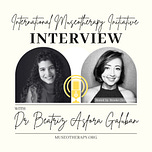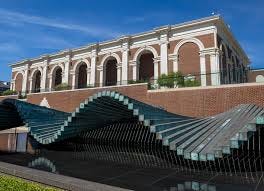For part 1 of this mini series, when I spoke with Dr. Carolyn Treadon, she gave us the therapy side of the story. For part 2, I wanted to hear from the other side of the collaboration — the museum side.
Enter Dr. Beatriz Galuban, an Assistant Professor of Art at Texas A&M University–Commerce and a museum educator whose work focuses on empathy, accessibility, and community. She earned her PhD in Art Education from the University of North Texas, where she explored the intersections of anxiety, empathy, and narrative in art education. At the Meadows Museum, she developed programs that connect visitors with art in ways that feel personal and human — including memory care programs for adults with Alzheimer’s and dementia.
“I started to care a little bit less about the object itself,” she told me, “and more about how we make meaning from objects. That led me toward storytelling, and toward education.”
For Dr. Galuban, museum education is not about simply transferring information. It’s about using art as a doorway — into memory, into dialogue, into community.
Connect with Dr. Galuban on LinkedIn ⬇️
Memory and Meaning
One of the most moving parts of our conversation was her description of the Meadows Museum’s memory care programs. Participants wait all summer for the program to come back, she said, and a single painting can unlock memories or emotions that spill into conversation.
For Dr. Galuban, this work is deeply personal — shaped by her own grandmother’s experience with dementia. It’s why she believes museums can’t just be neutral spaces. They must be spaces where people feel safe, where their stories matter.
To learn more about the Meadows Museum click here ⬇️
The Future of Museums
When I asked what she sees on the horizon, her answer was simple: empathy. Museums, she believes, are shifting from being collections-driven institutions to being community-centered ones — places where people can find connection, belonging, and even wellness.
“Museums are prime spaces for empathy,” she said. “The narrative potential in there allows us to create community, to create dialogue, a connection with other human beings. And I think we need that now more than ever.”
Listen to the Full Conversation
This article just scratches the surface of our conversation. The edited podcast episode highlights Dr. Galuban’s path from art history to education, her philosophy of storytelling and empathy, her passion for memory care, and her vision for the future of museums.
But the full unedited interview includes even more — including her thoughts on accessibility, her collaborations with other disciplines, and additional advice for students. Plus, if you want to hear me completely lose my cool professional NPR facade, that I like to believe I have for these interviews, you’ll catch the moment where I warn her I’m about to blow up her inbox asking for chances to work together.
🎧 Listen here:
If you’d like to hear the entire conversation, please consider becoming a paid subscriber to the International Museotherapy Initiative. Your support helps us keep exploring how museums can become spaces of care and connection.
✨ Coming Next Month ✨
If Dr. Galuban helped us see how museum educators center empathy and connection, Olivia Turner brings the curator’s eye to the conversation. In this upcoming interview, she shares what it’s like to shape exhibitions, the ways curators collaborate with educators, and how she thinks about the emotional impact of art on visitors. We also explore how curatorial work can intersect with wellness and reflection — and where art therapists might fit into the picture. You won’t want to miss this one.
Calling all Museophiles📣
Please recommend a guest writer or someone you would like to hear us interview! They could be affiliated with the museum industry in any way. We value your input, and we will not be collecting any data for this except to reach out!





